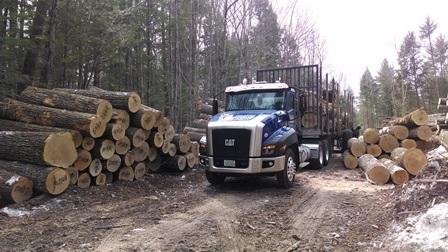- Tags:
- Timber Harvesting,
- Working Forests

Veneer-quality sawlogs ready for transport.
Remember the TV show The A-Team, in which the cigar-chewing hero John “Hannibal” Smith says: “I love it when a plan comes together”? Faced with a challenge, he would develop a plan, execute that plan under much adversity and by the end of the hour-long show put a big grin on his face and spout that line. Real life isn’t quite that fast, of course. And in forestry, as I may have mentioned in this column before, it can be a lifetime or more before a plan comes together.
For us a plan came together in a big way recently when we captured the full benefit of work completed by several generations of foresters. Prior to Forest Society ownership, perhaps 70 to 90 years ago, this forest had been managed by a forester. He looked over this grown-in field and, knowing that hardwoods would grow well on the site, worked to remove young softwoods.
Fast forward nearly 40 years and, then in the hands of the Forest Society, the forest was commercially thinned. This improvement thinning concentrated on removing low value, low quality trees, leaving the highest quality northern hardwoods and red oaks to mature with plenty of room. Hit the fast forward button again to 2014, and the forest was a well-stocked sawtimber-sized stand of veneer quality oaks and maples with a few yellow birches thrown in for good measure. This forest was ready for harvest at the same time that demand and prices for oak veneer spiked during a cold winter. (I didn’t say there wasn’t a little luck in this plan.)
Our average timber sale harvest is comprised mainly (70 percent) of low -value wood products like chips, firewood and pulpwood. So for the past several years our average stumpage income has been a modest $400 per acre, and that only because stumpage prices are rising. I mention all these numbers because when things are done right over a 90- to 100-year rotation in our oak forests, we reap the benefits with interest. In this case, those benefits included an average stumpage value that exceeded $3,000 per acre.
At the Forest Society we have the opportunity to capture a lot of information about our woods over a long time. With that information in hand we can plan our current timber sales to build upon the preparation work completed 20, 30, 40 or more years ago and reap the added reward of seeing someone’s original plan come together.
As a forester I take pride in the technology and expertise of today: the efficient machines and competent operators, the knowledgeable foresters, the logistics of the current log marketing system. But I am equally proud of those foresters and operators who in the past had a vision of what these woods could be if managed in a scientific way using the principles developed by a profession only born about the same time as the Forest Society (founded in 1901).
Not all of our forestland has been so well planned and managed, of course. Some of our acquired properties were completely harvested before our ownership. Some were less than well managed, leaving a forest that needed to be regenerated before we could consider managing what was left. In these instances the plan is at page one. Someday, if all goes well, some managing forester long after me will proudly, and with a big grin (cigar optional), proclaim, “I love it when a plan comes together.”
